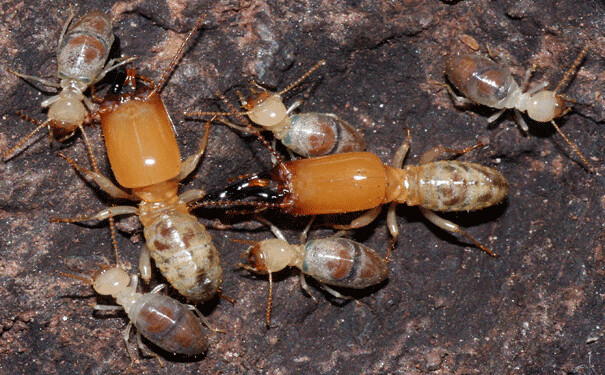Friday, November 25, 2016
Aging worker termites explode themselves in suicide missions
 |
| Meet the troops — two soldiers, two white workers and three blue workers with two blue spots between their thorax and abdomen. Image courtesy of R. Hanus |
Termites seem to have developed an explosive strategy for warfare.
Edward Osborne Wilson once wrote that while humans send their young men off to war, ants send in their old ladies. The Neocapritermes taracuatermites have taken this one step further and are using their ageing female workers as suicide troops, according to an international team of researchers.
This may seem like an unusual strategy until you realise that as these workers age, their mandibles are becoming duller. These cannot be renewed through moulting, so the termite’s food-collecting capacity decreases the older it gets. “In other words, the old workers are not as useful anymore for the colony but they can provide another service,” explains Robert Hanus from the Academy of Sciences of the Czech Republic, one of the authors of the study published in Science.
These ancient troops aren’t helpless: they have a secret weapon that they can and will use against ants and other termites. At some stage in their lives, two blue spots will appear on the termites’ back at the junction of the abdomen and the thorax. These are a pair of copper-containing protein crystals, which are enclosed within external pouches on the worker’s backs.
The researchers observed that these spots vary in size between the blue workers, with some white workers lacking spots entirely. The size of these crystals increases as the termite ages, allowing them to build up a toxic armoury for their final battle. When these blue workers do come under attack, they rupture their body walls and squirt a toxic compound onto the enemy, killing themselves in the process.
“The toxicity of the bursting liquid appears to result from a reaction of two components: the blue crystals on one side, stored outside the body cavity, and the haemolymph (a product of salivary glands),” Hanus says. The rupture causes the secretion of the haemolymph, then brings these two components into contact and causes a chemical reaction.
Ageing termites certainly appear to be more willing to sacrifice themselves than the younger workers, who prefer to stay at home and avoid aggressive interactions with ants and other termites. Instead of waiting for the enemy to come to them, Hanus says that the termites appear to be using this defensive device while foraging for food. “They often forage far from their home colonies and encounter ant predators and termite competitors.”
Subscribe to:
Post Comments (Atom)
No comments:
Post a Comment